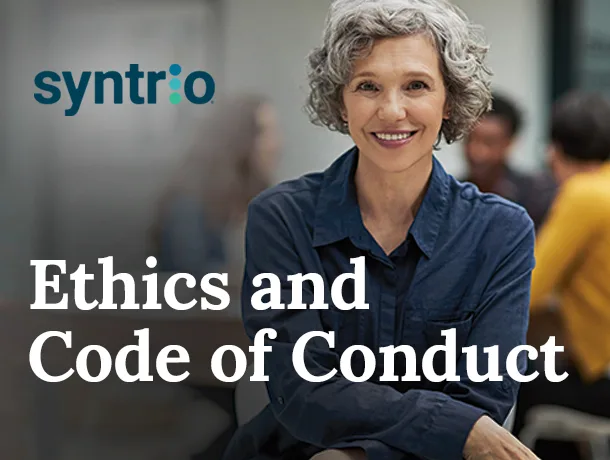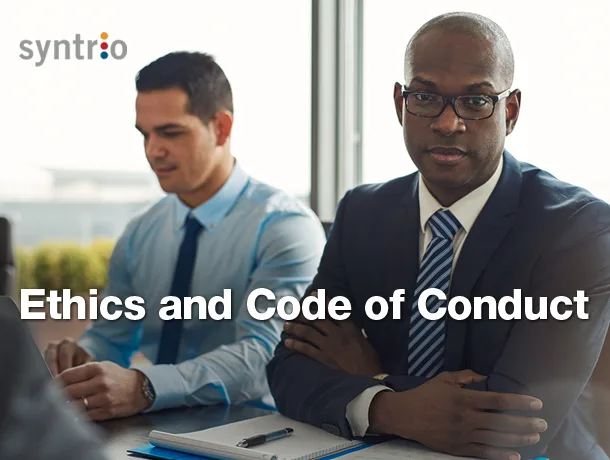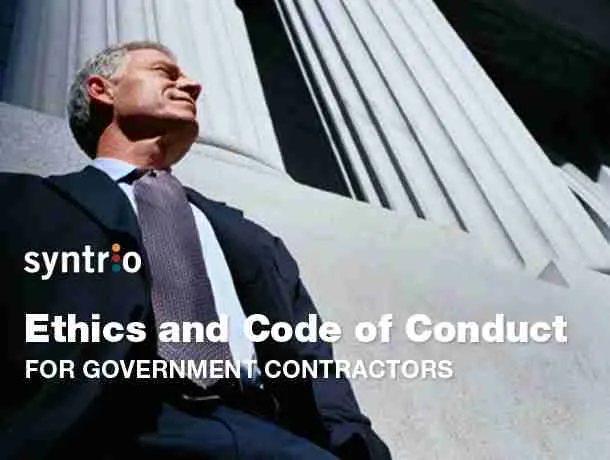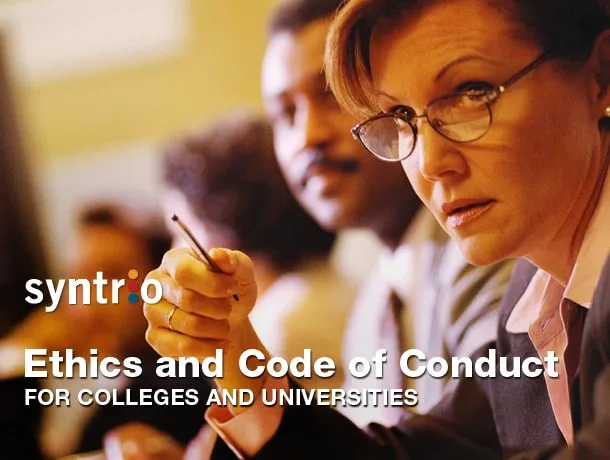POPULAR TOPICS – CODE OF CONDUCT
Steps to Developing a Code of Conduct
NEW! Online training courses and tools to help you effectively address workplace ethics and code of conduct.

What is a Code of Conduct?
A Code of Conduct is a Written Set of Principles & Ethical Standards.
Most companies strive to operate ethically and are committed to honesty, integrity, and trust. A code of conduct also called a code of ethics, is a written set of principles that typically works in conjunction with an organization’s mission statement to identify expectations regarding appropriate behavior. In effect, the code serves as an ethical roadmap for employees, management, vendors, and stakeholders to follow.
In 2002, the Sarbanes-Oxley Act made codes of conduct a virtual necessity from a legal standpoint. SOX mandated the development of a code for top executives and board members in all publicly traded U.S. companies. Organizations that do not have a code in place must now provide a plausible explanation as to its absence.
Employees, vendors, customers, prospective business partners, and investors want to be sure the company they work for or do business with conducts itself in the most ethical manner possible. Over the past quarter century, these developments have made codes of conduct more than just a sound business practice; they’re a virtual necessity.
Get Started!
Request our Essential Guide to
Creating an Effective Code of Conduct

STEPS FOR DEVELOPING A CODE OF CONDUCT
How to Structure Your Code of Conduct:
Six-Step Process
The specific content of a code of conduct will vary depending on factors such as the nature of the organization and the type of industry in which it conducts business. Here are several essential elements that should be part of any code.


STEP 1
Gathering
Information

STEP 2
Creating
the Draft

STEP 3
Reviewing
the Draft

STEP 4
Formally Adopting
the Code

STEP 5
Introducing
the Code

STEP 6
Enforcing
the Code

Gathering Information
The initial step in developing a code of conduct is for the code development committee to compile ideas about what the code should include. A good starting point is to examine the values listed in the corporate mission statement and make them a focal point of a brainstorming session. Reading sample codes by industry or topic can also provide valuable insight regarding framework and structure.


Creating the Draft
Once the primary content and structure of the code have been determined, the next step is to develop a draft. Many companies mistake choosing an attorney or other legal expert to create the document. This often results in a code filled with “legalese” that may be difficult to understand for most employees, thus defeating the purpose of its creation.
*A genuinely effective code of conduct is a positive, values-based document that serves as a guideline for appropriate behavior instead of merely a list of rules and regulations that must be obeyed at all costs.

Reviewing the Draft
Upon completion of the initial code draft, it should undergo a comprehensive review process to ensure it complies with the parameters developed in the initial step. The code development task force should conduct the review and perform any necessary edits. “Test drive” the code by submitting it to a targeted group of employees and stakeholders who are not otherwise involved in the code development process and incorporate their feedback as appropriate.
The completed document should then be submitted to top management for input. If legal counsel is not included in the review process, the paper should be presented to an attorney to ensure legal compliance.

Formally Adopting the Code
The appropriate parties should formally adopt the code of conduct, typically presenting it before the organization’s board of directors for approval.
Adoption legitimizes the code and expresses the organization’s sincere commitment to instilling an ethical culture. In smaller companies, ownership or top management should be responsible for adopting or approving the completed code.

Creating the Draft
Ideally, the company’s CEO or another top executive should unveil the code at a company-wide kickoff meeting or similar gathering. In addition, all organization members should receive a written copy of the code, and the document should be a staple of the new employee orientation package.
Other practical educational resources for supplementing code rollout include newsletter articles, emails to all employees and stakeholders, and the use of strategically placed posters throughout the facility.

Enforcing the Code
A code of conduct is no more valuable than the paper on which it is written unless there is a mechanism to enforce it effectively. For many organizations, code enforcement falls under the domain of the ethics and compliance officer. This individual is responsible for developing and monitoring processes such as reporting and investigating possible code violations and taking appropriate disciplinary action. In smaller organizations, the ethics and compliance officer may be the company’s human resources representative or a management team member.
*** According to the Society of Human Resource Management, even if company leadership is not directly involved in the creative process, its participation in the review process reinforces the organization’s commitment to its development and implementation.
Learn More With our Step-By-Step
Guide to Developing a Code of Conduct

How Code of Conduct Training Will Improve Your Workplace
Training methods involve presenting employees with potential scenarios and ethical dilemmas and instructing them to resolve these situations based on the language found in the code. Relevant case studies also serve as effective training tools. eLearning courseware can be a precious component of the educational process by providing employees with convenient online access to code training materials.
Code of Conduct Training is Essential for Your Employees
Ensure Your Employees Understand the Code of Conduct and How it Will Be Implemented.
While developing a code of conduct and taking appropriate steps to ensure proper implementation and enforcement requires time and effort, the process will provide numerous long-term benefits for your organization. From a legal standpoint, a code helps to ensure compliance with the Federal Sentencing Guidelines, Sarbanes- Oxley and other regulations, which can help the organization to avoid costly fines and other punitive measures.
A well-written, user-friendly code can develop a corporate culture built on a foundation of integrity and trust by providing an effective link between the company’s mission statement and values and its behavioral policies and procedures. A code of conduct highlights organizational values and illustrates why they are essential to success.
From a marketing and public relations standpoint, a code demonstrates to customers, prospects, and the general public that your organization is serious about ethically conducting all its activities, making the company one that others look forward to doing business with.
Finally, a code of conduct provides a consistent framework that employees can apply to every action they take during a workday. Whenever employees have doubts about whether an action is ethical, they have a readily accessible reference guide to help them make the right decision for themselves and the organization.
Top Featured Courses
FLEXCODE DEMO
FLEXCODE DEMO This demo is an example of a Syntrio Flexcode. This product uses existing ethics and code of conduct modules and can be configured to match your organization’s Code. Get in touch with your account executive for more information to see if a FLEXCODE could work for your organization.

Ethics and Code of Conduct – scode64
An organization’s standards of conduct and other policies serve important roles in protecting its reputation as a fair employer and responsible citizen. But these standards of conduct only work if everyone in the organization knows, understands, and can apply them in their daily activities. This training covers essential components of the organization’s business practices, including an introduction to business ethics; conflicts of interest; gifts, hospitality, and entertainment; handling of non-public information; data privacy; use of business resources; maintaining a civil and respectful workplace; and the importance of speaking up about concerns.

Ethics and Code of Conduct – scomp160
Ethics is about doing the “right” thing. In a business setting, ethics also ensures that all organization members share and uphold company values. This course introduces the concept of business ethics and highlights the company code of ethics and/or business conduct. Learners apply “the code” to a series of ethical issues common in the workplace. This course also discusses responsibilities, procedures, and “whistleblower” protections associated with reporting ethics and/or legal violations.

Ethics and Code of Conduct for Government Contractors
Business ethics involves educating and aligning the actions of individuals with relevant laws and the organization’s preferred values. This course discusses the many benefits of promoting business ethics and the legal requirements of government contractors concerning ethics and compliance. It highlights the organization’s Code of Ethics and/or Business Conduct. It asks learners to apply the Code to a series of hypothetical scenarios in which ethical issues may arise in the workplace. It also discusses responsibilities, procedures, and “whistleblower” protections associated with reporting ethics and/or legal violations.

Ethics and Code of Conduct for Colleges and Universities
This course will introduce you to the Colleges Code of Conduct and challenge you to apply the Code to a few scenarios. The purpose is to provide an overview of the Colleges expectations of its Members and representatives. The College expects its Members and their representatives to adhere to the highest ethical standards, including honesty, integrity, respect for others, fair dealing, diligence, prudence, and accountability in the use of the Colleges resources. If you have questions or discover gaps or inconsistencies in policy and application, please share your observation with your supervisor.

